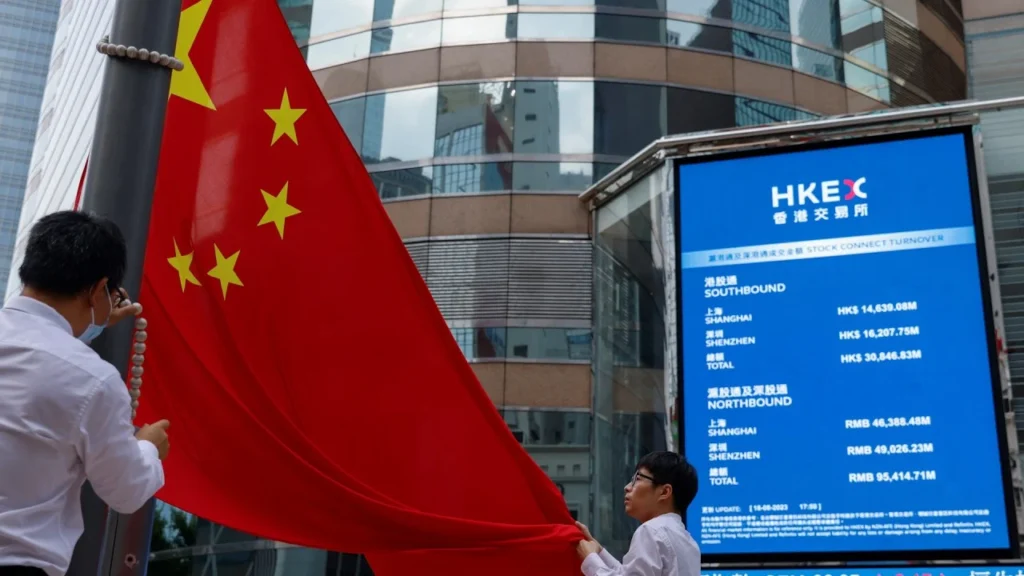
this is CNBC’s live blog covering Asia-Pacific markets.
SINGAPORE — The rally in Chinese markets lost steam on Tuesday after a briefing from the country’s National Development and Reform Commission provided few details on further stimulus.
While mainland China’s CSI 300 skyrocketed over 10% at the open Tuesday in its return from the Golden Week holiday, the index pared gains to a 5% rise later in the session.
Hong Kong’s Hang Seng index briefly plummeted over 10%, before recovering slightly to a smaller loss of 6.4%.
Other Asia-Pacific markets mostly fell on Tuesday, with investors watching August pay and spending data out from Japan.
Household spending in Japan fell 1.9% year-on-year in August in real terms, a softer fall compared to the 2.6% decline expected by a Reuters poll of economists.
The drop is the fastest pace of decline since January, which saw a 6.3% fall year-on-year. That decline also came before spring wage negotiations delivered the largest pay hikes to unionized Japanese workers in 33 years.
However, real wages rose in August, with data from the country’s statistics bureau indicating that wages climbed 2% to an average of 574,334 yen ($3,877.44).
South Korea’s Kospi was 0.72% lower, dragged by shares of heavyweight Samsung Electronics after it released worse than expected third quarter guidance.
The small cap Kosdaq was down 0.31%.
Australia’s S&P/ASX 200 slipped marginally.

| TICKER | COMPANY | NAME | PRICE | CHANGE | %CHANGE |
|---|---|---|---|---|---|
| Nikkei 225 Index | *NIKKEI | 38861.09 | -471.65 | -1.2 | |
| Hang Seng Index | *HSI | 21800.55 | -1299.23 | -5.62 | |
| S&P/ASX 200 | *ASX 200 | 8189.6 | -15.8 | -0.19 | |
| Shanghai | *SHANGHAI | 3514.55 | 178.05 | 5.34 | |
| KOSPI Index | *KOSPI | 2598.83 | -11.55 | -0.44 | |
| CNBC 100 ASIA IDX | *CNBC 100 | 10456.5 | -197.94 | -1.86 |
Overnight in the U.S., stocks slid as rising oil prices and higher Treasury yields weighed on market sentiment.
The Dow Jones Industrial Average dropped 0.94%, while the S&P 500 slid 0.96%. The Nasdaq Composite saw the largest loss, falling 1.18%.
The benchmark 10-year Treasury yield rose to 4.02%, marking the first time since August that the yield topped 4%.
Oil prices also rose as tensions in the Middle East remain high. U.S. crude climbed more than 3% to settle above $77 per barrel.
Hang Seng drops 6% even as mainland stocks rally
Hong Kong’s Hang Seng Index dropped more than 6% in early trading, dragged by consumer non cyclicals and health-care stocks.
The losses in the city stand in stark contrast to the rally on the mainland, which saw markets climb by over 7.5% as they reopened after a weeklong holiday.
Investors are also assessing China’s National Development and Reform Commission’s press conference that’s currently unfolding, for any signs of more stimulus or shifts in economic policy.
China markets skyrocket over 10% as stimulus fueled rally continues, stocks hit upper limits
Mainland Chinese markets saw a jump of over 10% on Tuesday as markets returned to trade after the Golden Week holiday, with the gains on the benchmark CSI 300 powered by health care and real estate stocks.
Data from LSEG showed several stocks hitting the 20% upper limit on the Shanghai stock exchange.
The Shanghai and Shenzhen stock exchanges has a 10% upper limit for mainboard stocks, and a 20% limit for stocks on Shanghai’s STAR market, a NASDAQ-style market for high-tech start-up companies.
However, Hong Kong’s Hang Seng index plunged 3%, in contrast to the optimism on the mainland.

Japan’s August real household spending falls, but wages rise
Household spending in Japan fell 1.9% in August year-on-year in real terms, marking its fastest decline since January.
Data from the country’s statistics bureau indicated that average household spending came in at 297,487 yen ($2,011.2) in August, up 1.5% in nominal terms.
However, real monthly income in Japan rose 2% in real terms and 5.6% in nominal terms to come in at 574,334 yen.
The data could present a conundrum for the Bank of Japan’s goal of having rising wages and prices, if domestic spending slows.
Samsung shares slip as company posts worse-than-expected third quarter guidance
Shares of South Korean heavyweight Samsung Electronics slipped 0.66% on Tuesday, after the company released its guidance for the third quarter that came in lower than analysts’ expectations.
The world’s top memory chip maker said operating profit for the quarter ending September is projected to be around 9.10 trillion won, marking a surge from last year’s 2.43 trillion Korean won.
Analysts polled by LSEG expected an operating profit of 11.456 trillion Korean won ($7.7 billion) for the quarter ended Sept. 30. Samsung’s revenue for the quarter was expected to hit 81.96 trillion won ($61 billion), according to LSEG estimates.
Read the full story here.
U.S. equities appear stretched at their current levels, JPMorgan says
JPMorgan believes U.S. equities currently look stretched after a strong recent rally, which could contribute to both higher concentration risk and potential for momentum reversal.
“If markets weaken, U.S. typically held up better than other regions during risk-off periods, but the concern is that the U.S. is trading at relative P/E and EPS highs, and that could constrain its absolute performance from here,” the bank wrote.
JPMorgan added that the U.S. is currently trading extremely expensive versus its peers, and that the region’s profitability versus the rest of the world might be peaking as well.
Goldman Sachs cuts 12-month recession odds to 15%
Given Friday’s strong reading of the September jobs report, Goldman Sachs chief economist Jan Hatzius cut his 12-month U.S. recession probability back to his long-term average of 15%. He had previously raised this after the jump in unemployment rate from June to July.
“The most important reason is that the unemployment rate fell to 4.051% in September, marginally below both the June level and the threshold that activates the ‘Sahm rule.’ Moreover, with nonfarm payroll growth of 254k surprising sharply to the upside, prior months revised higher, and household employment also solid, we now estimate an underlying jobs trend of 196k, well above our pre-payrolls estimate of 140k and modestly above our estimated ‘breakeven rate’ of 150-180k,” Hatzius wrote.
The economist added that fundamental upward pressure on the unemployment rate may have ended due to weaker labor supply growth and stronger labor demand growth.
Discover more from
Subscribe to get the latest posts sent to your email.




